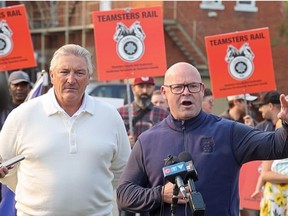Politics
Unions and Job Loss: Examining the Impact on American Workers

In recent discussions about labor unions in the United States, John Stossel challenges the widely held belief that unions are beneficial for workers. He argues that while unions may protect some workers, they can also contribute significantly to job losses. This debate has gained traction following events involving major companies, including UPS and Yellow Corp, where union negotiations led to changes that some claim harmed overall employment.
Union Negotiations and Their Consequences
Stossel’s video highlights a notable case involving the Teamsters and UPS. In 2021, UPS reported a profit of nearly $13 billion. The Teamsters demanded higher wages, and after negotiations, full-time drivers’ salaries increased to approximately $170,000 per year. While this success was celebrated as a victory for collective bargaining, it came at a cost. UPS raised its prices to accommodate the new wages, leading to a decline in competitiveness and ultimately resulting in a 12,000 worker layoff in 2024, followed by 20,000 the next year.
According to economist Lily Palagashvili from the Mercatus Center, excessive union regulations, including restrictions on subcontracting and limitations on work hours, hindered UPS’s ability to adapt and control costs. She commented, “These headline-grabbing union deals are delivering short-run sugar highs with long-run hangovers.”
The Yellow Corp Case
Another significant example is that of Yellow Corp, previously one of the largest freight carriers in the U.S. When the Teamsters threatened a strike over expedited healthcare and pension benefits, Yellow warned that a strike could lead to bankruptcy. Despite the warning, Teamsters leader Sean O’Brien insisted on their demands, stating, “The company has two more days to fulfil its obligations or we will strike.” While the strike was averted, Yellow ultimately shut down days later, resulting in the loss of 30,000 jobs.
When asked about the job losses, O’Brien expressed no remorse, attributing the situation to mismanagement. Palagashvili acknowledged Yellow’s existing financial troubles but emphasized the detrimental impact of union contracts that raised labor costs at a precarious time.
In parallel developments, the United Auto Workers initiated a strike against Stellantis, the parent company of Chrysler, securing a pay raise and a commitment for a new plant. However, this led to layoffs of 1,340 workers during the strike and an additional 2,450 in the following year. Similarly, the International Association of Machinists and Aerospace Workers went on strike against Boeing, which resulted in a workforce reduction of 10% just one month after the union secured its demands.
Historical Context and Modern Implications
Historically, regions in the U.S. once known as the “Steel Belt” have transformed into the “Rust Belt.” While some attribute this change to factors like free trade and globalization, Palagashvili contends that labor unions played a critical role. She argues that companies facing increased labor costs and frequent strikes chose to relocate rather than continue operations in these regions.
Stossel concludes that while unions may provide benefits for certain workers, they can have broader negative repercussions for many others. As discussions about labor rights and union influence continue, the impact on American jobs remains a crucial issue for policymakers, businesses, and workers alike.
-

 World3 months ago
World3 months agoScientists Unearth Ancient Antarctic Ice to Unlock Climate Secrets
-

 Entertainment3 months ago
Entertainment3 months agoTrump and McCormick to Announce $70 Billion Energy Investments
-

 Lifestyle3 months ago
Lifestyle3 months agoTransLink Launches Food Truck Program to Boost Revenue in Vancouver
-

 Science3 months ago
Science3 months agoFour Astronauts Return to Earth After International Space Station Mission
-

 Technology2 months ago
Technology2 months agoApple Notes Enhances Functionality with Markdown Support in macOS 26
-

 Top Stories1 week ago
Top Stories1 week agoUrgent Update: Fatal Crash on Highway 99 Claims Life of Pitt Meadows Man
-

 Sports3 months ago
Sports3 months agoSearch Underway for Missing Hunter Amid Hokkaido Bear Emergency
-

 Politics2 months ago
Politics2 months agoUkrainian Tennis Star Elina Svitolina Faces Death Threats Online
-

 Technology3 months ago
Technology3 months agoFrosthaven Launches Early Access on July 31, 2025
-

 Politics3 months ago
Politics3 months agoCarney Engages First Nations Leaders at Development Law Summit
-

 Entertainment3 months ago
Entertainment3 months agoCalgary Theatre Troupe Revives Magic at Winnipeg Fringe Festival
-

 Politics1 week ago
Politics1 week agoShutdown Reflects Democratic Struggles Amid Economic Concerns










